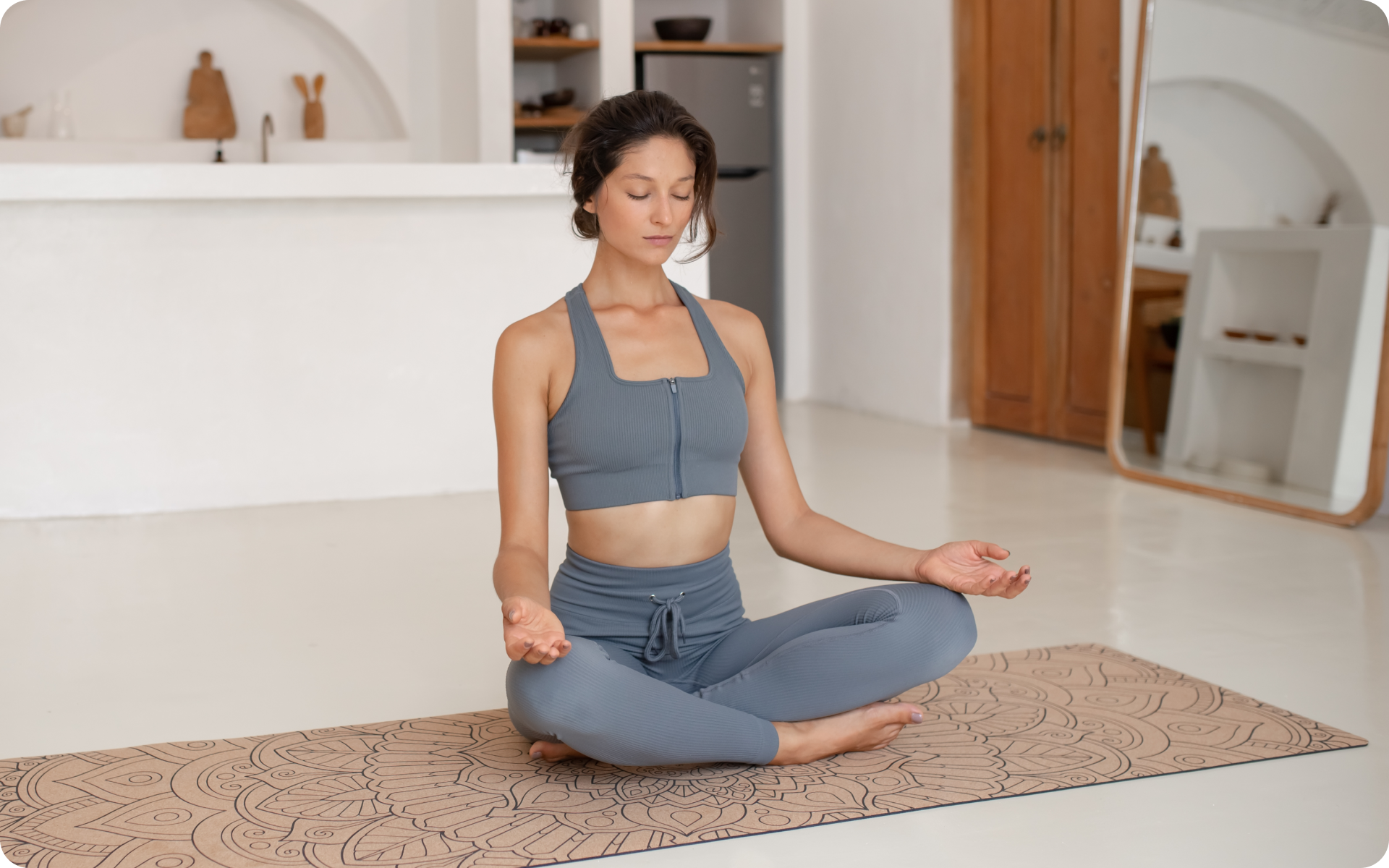In the modern world, we’re constantly bombarded with pressure, wouldn’t you agree?
Hectic routines, looming deadlines, and stress can bring people to the brink of burnout. This wreaks havoc on our mental well-being, making it essential for people to find ways to de-stress. Even though the stress-fighting champs, yoga, and meditation, have been around a while, a new approach is getting traction: somatic stress release.
If you’re done with yoga and meditation, or they haven’t been your standard bearers, you should consider somatic stress-release techniques.
What Is Somatic Stress Release?
To understand somatic stress release, you must first understand what’s meant by somatic.
Somatic means “of the body” and somatic stress release is a technique that is part of a holistic approach that emphasizes the mind-body connection. It refers to the concept that stress, trauma, or pain is stored deep within our bodies. This can later manifest as physical pain, muscle tension, or discomfort. To manage trauma, you need to acknowledge and release unresolved emotions that are linked to the trauma stored in the body with somatic stress release.
Somatic stress release techniques are a series of movements and gestures that are intended to relieve muscle tension and discomfort. They can relax the mind and help you get rid of unresolved emotions that are linked to trauma (8).
Running a never-ending rat race, shoving trauma further and further away, falling into self-harming thought patterns, living life that’s eclipsed by constant anxiety and fear – this is what an average person goes through every day. Not addressing it will only pull you deeper into a downward spiral. BetterMe: Meditation & Sleep app will help you gain a new perspective on life and help you regain that long-lost internal balance!
What Does a Somatic Release Feel Like?
The somatic release experience varies from person to person, but generally, you’ll feel relieved. It will be as if the entire tension has dissipated from your body.
Here are some of the general symptoms you may experience while doing somatic stress release (2):
Shoulder, Neck, and Jaw Muscles Relax
When we’re stressed, we often clench our jaws or tighten our fists. The muscles in our shoulders, neck, jaw, or head tighten in response to potential threats, often resulting in headaches and bruxism (teeth grinding). As we perform somatic stress release, our tensed muscles relax, our jaws loosen, our spines straighten, and we feel utterly relaxed.
To help clients relax their muscles, they’re often asked to lengthen their spine by imagining as if a string is tugging on their heads, pulling the spinal column. Clients with bruxism are asked to imagine a pillow of air between their upper and lower teeth. This often helps them relax their jaw muscles.
Gut Muscles Relax
When we are anxious or tense, our abdominal muscles tighten or contract as part of our body’s physiological (fight-or-flight) response. This state often leads to stomach pain, nausea, or diarrhea. As we work through our trauma, our gut and abdominal muscles relax, which eases our breathing.
Heartbeat Slows Down
Stored trauma or fear often increases the heartbeat and blood pressure as part of our sympathetic nervous system’s fight-or-flight response. Living with chronic trauma increases the likelihood of high blood pressure. Performing somatic techniques activates the parasympathetic nervous system, which helps lower the heartbeat and bring your blood pressure to normal.
Breathing Relaxes
Breathing patterns change when people experience stress in many ways. Some people hyperventilate when they’re experiencing fear or a stressful situation. As a result, their breath becomes shallow and quick as they breathe rapidly, as their chest muscles are overworking.
Others tend to hold their breath and feel as if they might faint. When people do somatic breathing exercises, their breathing patterns return to normal, i.e., they do diaphragmatic breathing, and their breaths become fuller and slower.
To help their breathing, clients are asked to focus on exhalation as this plays a significant role in activating the parasympathetic nervous system or, in simple words, making their body return to normal. One approach is the 4-6 (inhalation/exhalation) rule, where clients inhale for a 4 count and then exhale for a 6 count. The other is the 4-8 rule, where the exhalation is done for an 8 count, which puts the body at ease.
Hands and Feet Get Warmer
When people experience stress or fear, their fight or flight response activates, which prompts blood flow to the internal organs. As a result, their hands or feet become cold. During a somatic session, clients are asked to imagine their hands or feet getting warm. Once they get hold of their imagination, their hands and feet often start to get warm again, which suggests a physiological response to the mental imagery.
The Body Feels More Present
Finally, individuals who experience PTSD or deal with unresolved trauma often feel disconnected from their bodies, describing the feeling as being numb or out of tune from their bodies. When they undergo somatic stress release training, they feel more aware and more in tune with their bodies.
Read more: Somatic Healing Techniques: A Holistic Approach to Physical and Emotional Recovery
Can I Do Somatic Therapy on Myself?
While somatic therapy should be done under the guidance of a trained somatic therapist, you can engage in certain somatic techniques by yourself at home. Here are a few somatic stress release exercises you can perform to de-stress immediately (4):
Grounding
Grounding is a part of 12 guided somatic exercises that help you be “more present” and connected with reality when you experience painful memories or anxiety. You can do grounding in various ways.
Run cold water on your hands and notice how it feels. Focus on the temperature and how water moves from your wrist to your nails. After a few seconds, switch to warm water and feel how the sensation changes. Do this for a while until you feel relaxed (1).
Tense and relax your body by pressing your feet hard to the ground and focusing on how they connect with the ground. Hold the pressure for a while and then slowly release to see how your feet feel once you release the pressure. You can also squeeze a stress ball, focus on the pressure, and then release slowly.
Breathing Exercises
When we’re stressed, our breathing becomes erratic, so you may do a few breathing exercises to let go of fear or anxiety (3).
Perform diaphragmatic breathing by lying down or sitting comfortably. Place one hand on your chest and the other on your belly. Take a slow and deep breath and feel the air going in through your nose and filling up in your belly. Feel your hand on your belly rising as you breathe in and falling as you breathe out. Try to do it slowly.
You may also do box breathing, where you inhale for 4 counts, hold your breath for 4 counts, and then exhale slowly for 4 counts. Doing these exercises calms the nerves.
Visualization
Visualization is the act of imagining positive images and engaging in a constructive thought process. Research has shown that visualizing an action generates neural responses that are similar to actually performing an action. If you’re doing positive mental imagery, your brain will react the same and you will feel immensely better (6).
Start by imagining all the times you’ve felt happy, safe, and loved. Whenever you feel stressed, picture a secure and serene place where you may feel relaxed. You may also think about your friends or the people who make you feel safe.
Body Scanning
Body scanning helps you increase self-awareness and become more in tune with reality. Paying attention to different parts of your body helps you identify pain and areas of discomfort.
Lie down or sit comfortably and close your eyes or maintain a soft gaze. Start by focusing on your lower body and how your feet feel on the ground. Slowly move your focus to your ankles, legs, thighs, abdomen, and toward the upper body. Identify areas of discomfort as you move up your body, avoiding judgment. Slowly try to tense and release each part as you move up your body or place your hand on the areas you feel discomfort and take a deep breath. As you exhale, feel the tension release and then move to the next body part. Continue this process until you reach your face and head.
BetterMe: Meditation & Sleep app can help you transmute stress into serenity, pull you up from the doldrums, free your mind from the cares and worries of the world, quell racing thoughts and infuse you with tranquility! Start using it now and change your life!
Body Movement Techniques
Moving your body somatically helps you release stored unresolved emotions and pent-up tension. You could indulge in freestyle dancing, somatic yoga, or rolling your neck and shoulders after having hunched over the screen for a long time. Whatever you do, just focus on your body movements and how your body moves in space.
Containment with Safe Touch
This is a nurturing somatic technique that cultivates a sense of security and safety. It helps create self-compassion and makes you feel safe during low times. To do this (7):
Cup your hands, bring them toward your chest, and place them on your heart, feeling their warmth. Wrap your arms around yourself in a gentle hug. Feel your breath rising and falling. Then lay a soft blanket on top of your chest and feel the soft weight. You may rest on a soft pillow or hug a stuffed toy when you’re stressed. You’ll feel utterly relieved with its softness.
The Voo Sound
Making a voo sound with your mouth stimulates the vagus nerve, which signals your body to relax. Sit down comfortably and close your eyes or maintain a soft gaze. Take a deep belly breath, and as you exhale, create an extended voo sound. Feel the vibrations resonate within your body. Repeat this several times until you feel a sense of calm (3).
Shaking Tension
By shaking your body, you let go of physical tension as part of somatic stress release. Find a comfortable corner and start shaking your body vigorously, starting with your hands and arms and then moving to your chest and legs. Imagine you’re shaking off dust from your body. Shake your body for a couple of minutes and then slow down. Focus on how your body feels after shaking.
Progressive Muscle Relaxation (PMR)
Progressive muscle relaxation is all about tensing your muscles and then relaxing them to bring calm and ease. To perform this, stand or lie down comfortably. Start with your feet by tensing your toes or fingers as tightly as you can for approximately 5 seconds. Relax the muscles slowly and notice how the release feels. Proceed to other muscle groups and repeat the same until you reach your head.
Walking Meditation
Walking meditation benefits your physical health and is also good for your mental well-being. Start walking at a slow and gentle pace. Focus on how your feet touch the ground. Feel your arms and legs as they move with each step. Pay attention to your breath too. If your attention diverts, avoid judgment and slowly shift your attention by focusing on the sensation of walking and feeling your body in space.
These somatic exercises for releasing tension work wonders for your mental and physical well-being. Experiment with different frequencies, vibrations, and movements until you find relaxation and peace.
Is Somatic Healing Real?
Somatic healing helps the body release stored tension and unresolved emotions, which cultivates a sense of calm and positive well-being.
Also, somatic therapy is considered to be an essential branch of psychotherapy by the European Association of Psychotherapy. This shows the efficacy of somatic therapy and that it may be regarded as a helpful tool for healing stored trauma.
Is Yoga a Somatic Practice?
Yoga can be somatic, as long as you pay attention to your body and how it moves in space. Traditional yoga styles focus on external alignment while somatic yoga styles focus on internal alignment. Somatic yoga is performed with a heightened focus on your body sensations. During the session, you perform each pose slowly and meditatively by paying close attention to how each movement feels.
The focus is not on perfecting the pose but on noticing your body and focusing on various movements. By performing each yoga pose somatically, you can release tension and muscle stiffness, enhance body awareness, and improve your flexibility (10).
Read more: Somatic Dance: Liberation through Expression and Movement
What Are the Benefits of Somatic Stress Release?
Somatic stress release offers a litany of benefits for the human mind and body. Doing somatic release exercises does the following:
Brings Positivity
When we’re stressed, the brain is focused on survival as part of the body’s fight-or-flight response. This may be exhausting and deplete our energy. Somatic exercises help improve the mind-body connection and may help us exit the survival mode, enabling us to feel calm and relaxed (5).
Enhances Self-awareness
By focusing on your internal body, you become more aware of your feelings and emotions. In this way, you get more in touch with the pain signals your body sends you when you experience illness or injuries. This may often be a sign of unprocessed emotions. Somatic exercises help you acknowledge and manage these emotions.
How to Relieve Stress for a Woman
Women have to deal with a lot of responsibilities and chores every day. Therefore, they’re often stressed and face health issues. De-stressing is an essential part of staying healthy.
One way to combat stress is to be social and seek out time with friends and loved ones. Spending time with others makes us feel good and relieves stress (9). Another effective way of combating stress is to work out and be physically active. Working out releases endorphins, the feel-good hormones that elevate the mood.
FAQs
Can I do somatic therapy on myself?
No, somatic therapy should be conducted under the guidance of a trained somatic therapist. However, somatic techniques such as somatic breathing and grounding can be performed by yourself.
Is yoga a somatic practice?
Yes, yoga does consist of somatic principles. For example, somatic yoga combines somatic principles and traditional yoga and offers advantages including enhancing quality of life and flexibility (10). Performing each pose slowly and mindfully in somatic yoga is essential. By focusing on various body parts and noticing your body, you can induce a sense of calm and relaxation.
What does a somatic release feel like?
A somatic release feels incredibly calming and includes the unclenching of muscles, breath easing, heart rate and blood pressure falling, and the body entering a relaxed state.
The Bottom Line
Performing somatic stress release exercises is an important part of acknowledging and managing unresolved trauma. However, some individuals may require somatic therapy, which should be done under the guidance and supervision of a licensed somatic therapist, as the experience tends to be somewhat overwhelming for some individuals. It’s important to remember that somatic therapy is a gradual process and it may take a couple of weeks to months to fully let go of the stress in question.
DISCLAIMER:
This article is intended for general informational purposes only and does not serve to address individual circumstances. It is not a substitute for professional advice or help and should not be relied on for making any kind of decision-making. Any action taken as a direct or indirect result of the information in this article is entirely at your own risk and is your sole responsibility.
BetterMe, its content staff, and its medical advisors accept no responsibility for inaccuracies, errors, misstatements, inconsistencies, or omissions and specifically disclaim any liability, loss or risk, personal, professional or otherwise, which may be incurred as a consequence, directly or indirectly, of the use and/or application of any content.
You should always seek the advice of your physician or other qualified health provider with any questions you may have regarding a medical condition or your specific situation. Never disregard professional medical advice or delay seeking it because of BetterMe content. If you suspect or think you may have a medical emergency, call your doctor.
SOURCES
- 4 Somatic Therapy Exercises for Healing from Trauma (2021, psychcentral.com)
- 6 Promising Signs Your Body is Releasing Trauma (2023, therapistsinphiladelphia.com)
- 10 Somatic Exercises To Release Pent-Up Emotions (2024, betterme.world)
- 12 Effective Somatic Therapy Exercises for Holistic Healing (2024, monakirstein.com)
- Benefits of Somatic Therapy (2022, integrativelifecenter.com)
- Seeing Is Believing: The Power of Visualization (2009, psychologytoday.com)
- Somatic experiencing – effectiveness and key factors of a body-oriented trauma therapy: a scoping literature review (2021, ncbi.nlm.nih.gov)
- Somatic release: small moves to relieve big tension (2022, cfib-fcei.ca)
- Stressed Out? 5 Tips for Women to Stay Heart Health (n.d., hopkinsmedicine.org)
- What Is Somatic Yoga? Everything You Need To Know (n.d., brettlarkin.com)










